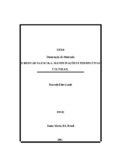| dc.creator | Lamb, Marcelo Eder | |
| dc.date.accessioned | 2019-08-08T18:40:11Z | |
| dc.date.available | 2019-08-08T18:40:11Z | |
| dc.date.issued | 2002-08-05 | |
| dc.identifier.uri | http://repositorio.ufsm.br/handle/1/17823 | |
| dc.description.abstract | By observing that playing at school reduced itself to the repetition of playings or
was free realized, without any pedagogical intervention, it awaked in us the
interest of search the pedagogical perspectives include in the different cultural
ways through which playing appears in the educational acts in a public
Educational Institution from “São Pedro do Sul”. We substantiated our study in
the following authors: Leontiev (1988), Vigotsky (1988), Brougère (1994), who
speak about playing; Ayalla (1995), Brandão (1985), Fávero (1983) that deal
witch culture; Paulo Freire, who speaks about education and its importance;
Trebells (1992), about “to move”; and in Adorno (1995), that works with
emancipation. The people that participated were the teachers of Childish
Education and the first grades of Primary School. There happened group
interviews (Group Discussion). This least had the objective of building strategies
for the modification of the way that playing have been found in the educational
practices. We concluded that teachers seem don’t know their role in the playing
process. What predominate is the free play in the playing process. What
predominate is the free play in the playtime, as well as in the Phisical Education
classes. On the other hand, in classroom, the playing process seems to have the
function of helping the learning of some contents. Teachers can’t also understand
the importance of playing for the children. Based on the Group Discussions, it
was possible to identify some increasing in the understanding of the importance of
playing and creating strategies, some of them are: to create situations of playing;
linking children, family and school; besides of the creation of “controlled
playtime”. | eng |
| dc.language | por | por |
| dc.publisher | Universidade Federal de Santa Maria | por |
| dc.rights | Attribution-NonCommercial-NoDerivatives 4.0 International | * |
| dc.rights.uri | http://creativecommons.org/licenses/by-nc-nd/4.0/ | * |
| dc.subject | Educação | por |
| dc.subject | Ensino | por |
| dc.subject | Cultura | por |
| dc.subject | Prática educativa | por |
| dc.subject | Escola | por |
| dc.subject | Recreação | por |
| dc.title | O brincar na escola: manifestações e perspectivas culturais | por |
| dc.title.alternative | Playing at school: cultural manifestation and perspectives | eng |
| dc.type | Dissertação | por |
| dc.description.resumo | Ao observar que o brincar na escola se resumia em uma repetição de brincadeiras
ou era realizado livremente, sem qualquer intervenção pedagógica, despertou-se
em nós o interesse de investigar as perspectivas pedagógicas contidas nas
diferentes formas culturais com que o brincar se manifesta nas práticas educativas
em uma instituição de ensino da Rede Estadual do Município de São Pedro do
Sul. Fundamentamo-nos nos seguintes autores: Leontiev (1988), Vigotsky (1988),
Brougére (1994), que falam sobre o brincar; Ayalla (1995), Brandão(1985),
Fávero (1983), que tratam da cultural; Paulo Freire, que fala do papel da
educação; Trebells (1992), sobre o “se movimentar”; e em Adorno (1995),quando
trabalha com a emancipação. Os participantes foram os professores da Educação
Infantil e das séries iniciais do Ensino Fundamental da escola escolhida, tendo
sido realizadas entrevistas individuais e entrevistas coletivas (Grupo de
Discussão). Este último teve por objetivo construir estratégias para a
transformação da forma com que o brincar se encontrava nas práticas educativas.
Concluímos que os professores parecem não reconhecer qual o seu papel no
brincar. O brincar que predomina é o brincar livre, tanto nos recreios como nos
momentos denominados: aulas de Educação Física. Já na sala de aula, o brincar
demonstrou ter a função de auxiliar a aprendizagem de algum conteúdo, mas os
professores também não conseguem sistematizar qual seria a importância do
brincar para a criança. A partir dos Grupos de Discussão, foi possível constatar
uma sensível ampliação no entendimento destes da importância para o brincar e
construir estratégias, entre elas: proporcionar situações de brincar integrando as
crianças, a família e a escola; e a implementação do “recreio dirigido”. | por |
| dc.contributor.advisor1 | Baecker, Ingrid Marianne | |
| dc.contributor.advisor1Lattes | http://lattes.cnpq.br/7708814973447427 | por |
| dc.contributor.referee1 | Goellner, Silvana Vilodre | |
| dc.contributor.referee1Lattes | http://lattes.cnpq.br/2260335592246715 | por |
| dc.contributor.referee2 | Gil, Joao Pedro Alcantara | |
| dc.contributor.referee2Lattes | http://lattes.cnpq.br/3664030812532638 | por |
| dc.contributor.referee3 | Nunes, Ana Luiza Ruschel | |
| dc.contributor.referee3Lattes | http://lattes.cnpq.br/2446074749753703 | por |
| dc.creator.Lattes | http://lattes.cnpq.br/4733298775947401 | por |
| dc.publisher.country | Brasil | por |
| dc.publisher.department | Educação | por |
| dc.publisher.initials | UFSM | por |
| dc.publisher.program | Programa de Pós-Graduação em Educação | por |
| dc.subject.cnpq | CNPQ::CIENCIAS HUMANAS::EDUCACAO | por |
| dc.publisher.unidade | Centro de Educação | por |



